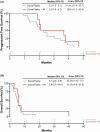Combined immune checkpoint inhibition with durvalumab and tremelimumab with and without radiofrequency ablation in patients with advanced biliary tract carcinoma
- PMID: 38205877
- PMCID: PMC10904979
- DOI: 10.1002/cam4.6912
Combined immune checkpoint inhibition with durvalumab and tremelimumab with and without radiofrequency ablation in patients with advanced biliary tract carcinoma
Abstract
Background: Current standard of care for advanced biliary tract cancer (BTC) is gemcitabine, cisplatin plus anti-PD1/PD-L1, but response rates are modest. The purpose of this study was to explore the efficacy and safety of durvalumab (anti-PD-L1) and tremelimumab (anti-CTLA-4), with and without an interventional radiology (IR) procedure in advanced BTC.
Methods: Eligible patients with advanced BTC who had received or refused at least one prior line of systemic therapy were treated with tremelimumab and durvalumab for four combined doses followed by monthly durvalumab alone with and without an IR procedure until the progression of disease or unacceptable toxicity. Objective response was assessed through CT or MRI by Response Evaluation Criteria in Solid Tumors (RECIST, version 1.1) every 8 weeks. Adverse events (AEs) were recorded and managed. The primary endpoint was 6-month progression-free survival (PFS).
Results: Twenty-three patients with advanced BTC were enrolled; 17 patients were assigned to treatment with durvalumab and tremelimumab (Durva/Treme); and 6 patients were treated with the combination of durvalumab, tremelimumab plus IR procedure (Durva/Treme + IR). The best clinical responses in the Durva/Treme arm were partial response (n = 1), stable disease (n = 5), progressive disease (n = 5), and in the Durva/Treme + IR arm: partial response (n = 0), stable disease (n = 3), progressive disease (n = 3). The median PFS was 2.2 months (95% CI: 1.3-3.1 months) in the Durva/Treme arm and 2.9 months (95% CI: 1.9-4.7 months) in the Durva/Treme + IR arm (p = 0.27). The median OS was 5.1 months (95% CI: 2.5-6.9 months) in the Durva/Treme arm and 5.8 months (95% CI: 2.9-40.1 months) in the Durva/Treme + IR arm (p = 0.31). The majority of AEs were grades 1-2.
Conclusion: Durva/Treme and Durva/Treme + IR showed similar efficacy. With a manageable safety profile. Larger studies are needed to fully characterize the efficacy of Durva/Treme ± IR in advanced BTC.
Trial registration: ClinicalTrials.gov NCT02821754.
Keywords: biliary tract cancer; cholangiocarcinoma; cryoablation; durvalumab; immune checkpoint inhibitor; interventional radiology; radiofrequency ablation; tremelimumab.
Published 2024. This article is a U.S. Government work and is in the public domain in the USA. Cancer Medicine published by John Wiley & Sons Ltd.
Conflict of interest statement
These studies pose no conflicting financial interests for any of the authors.
Figures






Similar articles
-
First-line durvalumab therapy alone or in combination with tremelimumab for metastatic head and neck squamous cell carcinoma: A cost-effectiveness analysis.PLoS One. 2025 May 16;20(5):e0324057. doi: 10.1371/journal.pone.0324057. eCollection 2025. PLoS One. 2025. PMID: 40378108 Free PMC article.
-
Durvalumab alone and durvalumab plus tremelimumab versus chemotherapy in previously untreated patients with unresectable, locally advanced or metastatic urothelial carcinoma (DANUBE): a randomised, open-label, multicentre, phase 3 trial.Lancet Oncol. 2020 Dec;21(12):1574-1588. doi: 10.1016/S1470-2045(20)30541-6. Epub 2020 Sep 21. Lancet Oncol. 2020. PMID: 32971005 Clinical Trial.
-
Tolerability and efficacy of durvalumab, either as monotherapy or in combination with tremelimumab, in patients from Asia with advanced biliary tract, esophageal, or head-and-neck cancer.Cancer Med. 2022 Jul;11(13):2550-2560. doi: 10.1002/cam4.4593. Epub 2022 May 24. Cancer Med. 2022. PMID: 35611499 Free PMC article. Clinical Trial.
-
Durvalumab: A Review in Advanced Biliary Tract Cancer.Target Oncol. 2023 Nov;18(6):965-972. doi: 10.1007/s11523-023-01007-y. Epub 2023 Nov 9. Target Oncol. 2023. PMID: 37943483 Free PMC article. Review.
-
Single or combined immune checkpoint inhibitors compared to first-line platinum-based chemotherapy with or without bevacizumab for people with advanced non-small cell lung cancer.Cochrane Database Syst Rev. 2020 Dec 14;12(12):CD013257. doi: 10.1002/14651858.CD013257.pub2. Cochrane Database Syst Rev. 2020. Update in: Cochrane Database Syst Rev. 2021 Apr 30;4:CD013257. doi: 10.1002/14651858.CD013257.pub3. PMID: 33316104 Free PMC article. Updated.
Cited by
-
Targeting immune checkpoints in hepatocellular carcinoma therapy: toward combination strategies with curative potential.Exp Hematol Oncol. 2025 May 2;14(1):65. doi: 10.1186/s40164-025-00636-5. Exp Hematol Oncol. 2025. PMID: 40317077 Free PMC article. Review.
-
Immune checkpoint inhibitors: From friend to foe.Toxicol Rep. 2025 Apr 24;14:102033. doi: 10.1016/j.toxrep.2025.102033. eCollection 2025 Jun. Toxicol Rep. 2025. PMID: 40353246 Free PMC article.
-
Nanostrategies synergize with locoregional interventional therapies for boosting antitumor immunity.Bioact Mater. 2025 May 31;51:634-649. doi: 10.1016/j.bioactmat.2025.05.016. eCollection 2025 Sep. Bioact Mater. 2025. PMID: 40521175 Free PMC article.
-
Anti-vascular endothelial growth factor treatment potentiates immune checkpoint blockade through a BAFF- and IL-12-dependent reprogramming of the TME.Immunity. 2025 Apr 8;58(4):926-945.e10. doi: 10.1016/j.immuni.2025.02.017. Epub 2025 Mar 14. Immunity. 2025. PMID: 40088889
-
Ultrasound-guided percutaneous radiofrequency ablation combined with anti-PD-1 for the treatment of prostate cancer: an experimental study.Front Oncol. 2025 Mar 24;15:1527763. doi: 10.3389/fonc.2025.1527763. eCollection 2025. Front Oncol. 2025. PMID: 40196732 Free PMC article.
References
-
- Bridgewater JA, Goodman KA, Kalyan A, Mulcahy MF. Biliary tract cancer: epidemiology, radiotherapy, and molecular profiling. Am Soc Clin Oncol Educ Book. 2016;35:e194‐e203. - PubMed
-
- Izquierdo‐Sanchez L, Lamarca A, La Casta A, et al. Cholangiocarcinoma landscape in Europe: diagnostic, prognostic and therapeutic insights from the ENSCCA Registry. J Hepatol. 2022;76(5):1109‐1121. - PubMed
-
- Valle JW, Kelley RK, Nervi B, Oh DY, Zhu AX. Biliary tract cancer. Lancet. 2021;397(10272):428‐444. - PubMed
-
- Forner A, Vidili G, Rengo M, Bujanda L, Ponz‐Sarvise M, Lamarca A. Clinical presentation, diagnosis and staging of cholangiocarcinoma. Liver Int. 2019;39(Suppl 1):98‐107. - PubMed
Publication types
MeSH terms
Substances
Associated data
Grants and funding
LinkOut - more resources
Full Text Sources
Medical
Research Materials

